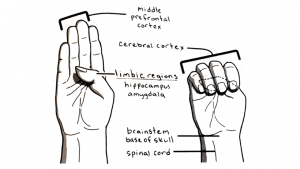I recently heard a student say, “My brain stopped working” in response to their negative actions in the classroom setting. The student understood the behavior was not appropriate nor conducive for the classroom, but their statement reflects a critical stage of the developing brain. Dr. Daniel Siegal uses a “handy model” to illustrate the principle of “flipping your lid.”
In this illustration you can see the center part of the brain represented by the thumb. This area of the brain, known as the limbic system, is the area of the brain associated with emotional regulation and fear responses. The brain stem, represented by the wrist, is the oldest part of the brain and controls necessary bodily functions like breathing and heart rate. The frontal lobe, represented by the fingers, is the last area of the brain to develop and it is involved with all higher forms of functioning and reasoning. It wraps around the center part of the brain and acts a control board for emotional and behavioral responses.
As a child develops, the connections between all areas of the brain grow stronger. The term, “flipping your lid” can be seen on a neurological level. As seen in the illustration, a strong emotional/fear response results in a dissociation between the frontal lobe and the center of the brain. The brain essentially flips its lid as the frontal reasoning area of the brain loses its ability to control the central fear responses of the brain.
The neurons that connect the frontal lobe to the center of the brain continue to develop until an individual’s mid-20’s. This does not mean that children are excused from out-of-control behavior. More so, this demonstrates the importance of educating children and helping them build those connections as they continue to develop. Talking to children before and after emotional outbursts stimulates growth in the brain’s neural fibers and helps them better regulate their reactions in the future.
Its exciting to see the science that helps explain children’s behavior and even more exciting to know that the time we spend talking with our children and students really makes a difference!
Created by Ally DeMaagd, Social Work Intern

Leave a Reply